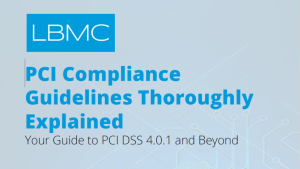Protecting Cardholder Data in the Era of PCI DSS 4.0.1
Key takeaway: PCI DSS 4.0.1 goes beyond annual audits — it’s about embedding compliance into your daily operations and governance framework to strengthen trust and security across your organization.
Stay ahead of evolving PCI standards.
Download the PCI Compliance Guidelines Thoroughly Explained to understand how PCI DSS 4.0.1 reshapes compliance for merchants, service providers, and technology-driven organizations. This guide breaks down what’s new, what’s changed, and how to make compliance a business-as-usual practice that supports both security and governance goals.
If your organization stores, processes, or transmits payment card data, you are responsible for maintaining compliance with the Payment Card Industry Data Security Standard (PCI DSS). The latest version — PCI DSS 4.0.1 — represents a shift toward continuous compliance, executive accountability, and risk-based flexibility across all industries that handle cardholder data.
Whether you’re a retailer, service provider, SaaS platform, or healthcare organization, understanding and operationalizing PCI DSS 4.0.1 is essential to protecting sensitive data, building customer trust, and meeting evolving security expectations.
The PCI Compliance Guidelines Thoroughly Explained guide provides practical insights for compliance officers, IT leaders, and GRC managers on topics such as:
- What PCI DSS 4.0.1 means for your organization and how it differs from version 3.2.1.
- How merchants and service providers can demonstrate compliance through the Report on Compliance (ROC) or Self-Assessment Questionnaire (SAQ).
- The most significant new requirements, including multi-factor authentication for all access to the Cardholder Data Environment, targeted risk analyses, and authenticated vulnerability scanning.
- How to define and validate PCI scope in modern, cloud-based environments.
- Ways to integrate PCI compliance into governance and risk management programs as a business-as-usual activity.
- How to reduce scope and simplify compliance through outsourcing, tokenization, and P2PE solutions.
- Best practices for leveraging PCI SSC guidance and FAQs to stay ahead of evolving requirements.

